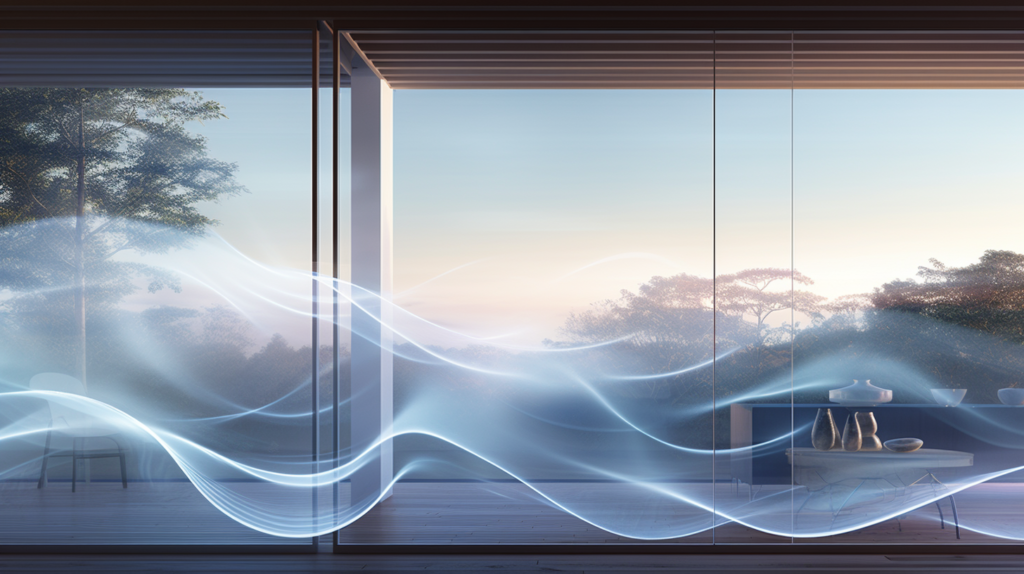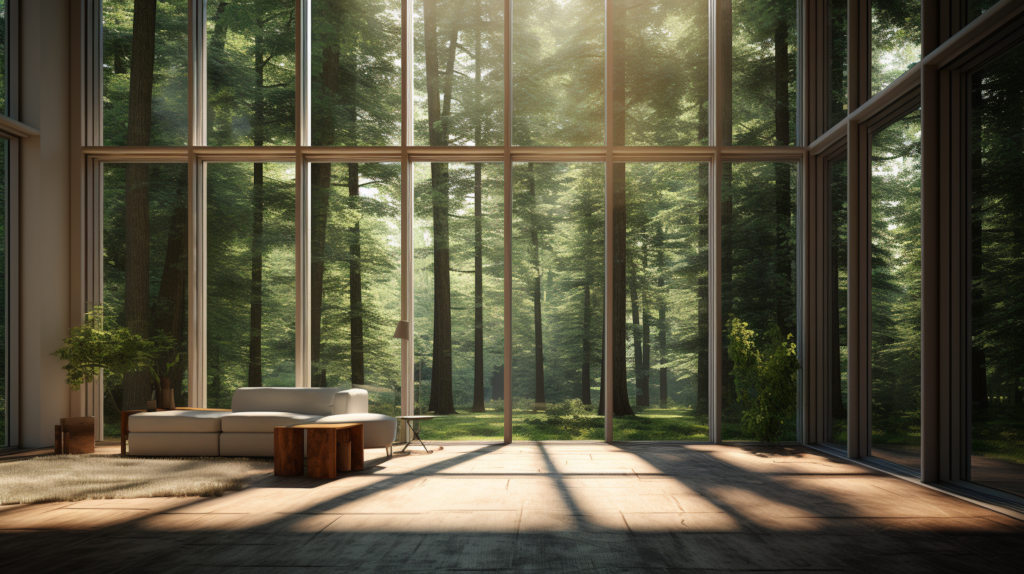Picture a tranquil haven within your home, insulated from the relentless hum of urban life—this could be the reality with triple-glazed windows. But are these sophisticated panes truly the guardians of silence we believe them to be?
The assertion that triple-glazing can soundproof our spaces is not without its complexities and caveats.
In the ensuing exploration, we’ll peel back the layers of glass and gas to evaluate the true extent of their soundproofing capabilities.
With precision, we’ll weigh the harmony of heat and sound insulation against the dissonance of uninvited noise.
Let’s dive in and decipher whether triple-glazed windows hold the key to a quieter life.
Understanding Sound Transmission In Homes

The journey of sound through a home is a tale of two distinct characters: airborne and structure-borne noise.
Airborne noise, akin to a floating melody or a distant conversation, meanders through the air, seeking crevices and openings in a home’s defenses.
This type of noise, such as the hum of a refrigerator or the clangor of traffic, relies on air as its medium and can be surprisingly invasive, penetrating walls, ceilings, and especially windows, which can act like diaphragms, resonating with the sounds of the outside world.
Structure-borne noise, by contrast, is more like an unwelcome vibration that enters a home’s very skeleton, traveling through beams, joists, and the foundation itself.
This kind of noise is born from impact or mechanical sources—think of the thud of a closing door or the vibrations of a washing machine in operation.
Unlike its airborne counterpart, structure-borne noise doesn’t seek out gaps; it spreads through solid materials, often amplifying as it goes, turning entire rooms into unwitting speakers.
In this symphony of sounds, windows can be both a vulnerable entry point and a potential barrier. Their performance in sound insulation is paramount to the tranquility of a living space.
However, not all windows are created equal in their acoustic properties.
The type and quality of the window, the materials used, and the precision of its installation all play a significant role in its ability to muffle the external clamor.
It is in this realm that triple-glazed windows emerge as a notable solution, offering a buffer against the noise with their multi-layered construction.
What Are Triple-Glazed Windows?

Triple-glazed windows are the titans of window design, a step above their single and double-glazed relatives.
They are composed of three panes of glass, each separated by an air or gas-filled space. These windows are not just about adding more glass; they’re about engineering a barrier that can withstand the onslaught of both temperature extremes and noise pollution.
The construction of a triple-glazed window is an exercise in precision. The panes of glass and the spaces between them must work in concert to create a seal that keeps the unwelcome aspects of nature at bay.
The gases used between the panes—typically argon or krypton—are chosen for their insulating properties, both thermal and acoustic.
Argon is cost-effective and provides a good balance of insulation and sound reduction. Krypton, while more expensive, offers a denser medium for even greater control over heat and noise transfer.
But why does this matter? In the context of soundproofing, every additional barrier that a sound wave encounters on its path to the interior of a home can significantly reduce its intensity.
Triple-glazed windows, with their multiple layers and insulating gases, are designed to dampen the vibrational energy of sound, converting it into heat energy that dissipates harmlessly between the panes.
How Does Triple-Glazed Window Soundproof?

When a sound wave hits a triple-glazed window, it encounters not one, not two, but three layers of glass, each with its own resonant frequency.
The air or gas-filled spaces act as cushions, absorbing some of the wave’s energy. The result is a noticeable decrease in the volume of sounds entering the home.
This is particularly true for high-frequency noises, such as the whine of a leaf blower or the chatter of birds at dawn.
Yet, the science of soundproofing isn’t without its nuances.
Resonance, the phenomenon where the natural frequency of the window aligns with that of the incoming sound wave, can lead to amplification rather than reduction of certain frequencies.
It’s an acoustic challenge that requires a sophisticated response. Varied glass thicknesses within the same window unit can help, as can laminated glass, which features a layer of plastic between glass panes that disrupts sound waves.
The design process for these windows is a meticulous balancing act, taking into account the dimensions of the air gaps, which must be just right to prevent the ‘drum effect‘—a resonance that can occur when the gap between panes matches the wavelength of prevalent noises.
Careful engineering is required to ensure that these windows are tuned not to amplify but to attenuate the intruding sounds.
Limitations Of Triple Glazing In Soundproofing

For all their benefits, triple-glazed windows are not without their drawbacks. They are champions against certain types of noise, especially higher frequencies.
Some sounds like the low-frequency rumblings of distant thunder or the steady drone of an airplane—can still find their way through.
These sounds have longer wavelengths, which are less impeded by the multiple layers of glass and air.
Design flaws can also limit a triple-glazed window’s effectiveness. If the air gaps are not optimized, they can create resonance chambers that amplify rather than dampen sound.
Especially at certain troublesome frequencies. Moreover, if the thickness of the glass panes is uniform, they might all resonate at the same frequency, nullifying the benefits of having multiple layers.
The installation is as crucial as the window’s design. An impeccable, airtight installation is a cornerstone of effective soundproofing.
Even the most sophisticated triple-glazed window can fail to perform if it’s not properly sealed into the building envelope.
Gaps, however minor, between the window frame and the building can allow noise to bypass the glass entirely, much like a rock skipping over water.
To ensure that these limitations do not undermine the effectiveness of triple-glazed windows, it is essential to address both the design and the installation with equal care.
The right combination of glass thickness, air gap width, and expert installation can turn what is already a good soundproofing solution into an excellent one.
Enhancing Triple Glazed Windows For Better Sound Insulation

The pursuit of silence in a noisy world often leads homeowners to explore ways to enhance the natural soundproofing qualities of their triple-glazed windows.
Weatherstripping is one of the simplest yet most effective enhancements. It involves applying a strip of material around the window frame to seal it against air and sound leakage.
This additional layer of protection can significantly improve the window’s ability to block noise.
Sealing cracks around the window frames is another method to ensure that the soundproofing capabilities of the window are not compromised.
Over time, windows can develop small cracks due to building movement, temperature changes, or simply the settling of materials.
These cracks, while often barely visible, can be significant conduits for noise. Using high-quality, flexible sealants can address these vulnerabilities, preserving the quietude within.
For those seeking the utmost in sound insulation, additional enhancements can be made to the triple-glazed windows themselves.
Laminated glass, with its sandwiched layer of vibration-dampening plastic, is one such upgrade. Another is the strategic use of differing glass pane thicknesses to create a discordant barrier that further disrupts sound waves.
The installation process must be given the attention it deserves.
Proper installation can mean the difference between a window that is merely decorative and one that stands as a bulwark against the noise.
It is vital to engage with professionals who understand the importance of airtight seals and who will treat the installation with the precision it requires.
By combining the inherent soundproofing properties of triple-glazed windows with these enhancements, homeowners can achieve a level of quiet that is not just desirable, but essential for comfort and well-being.
It is a meticulous process, but one that yields dividends in the form of serene interiors, undisturbed by the clamor of the external environment.
Conclusion
In the quest to create sanctuaries of silence within our homes, Triple-glazed windows emerge as both a shield and a solution.
They are an embodiment of the intricate dance between form and function, where the quest for thermal efficiency aligns with the need for acoustic tranquility.
Yet, as with any finely tuned instrument, the purity of the sound—or in this case, the absence of it—lies in the details.
The thickness of the glass, the width of the air gaps, the choice of inert gas, and the precision of installation all play their parts in the symphony of soundproofing.
Triple-glazed windows are not a universal remedy for noise pollution, but they are a significant step in the right direction.
When implemented with care and enhanced with the right materials and techniques, they can provide an oasis of calm in the bustling soundscape of modern life.
In this way, triple-glazed windows do not merely insulate; they transform our living spaces into havens of peace, proving that, in the battle against noise, silence is indeed golden.
